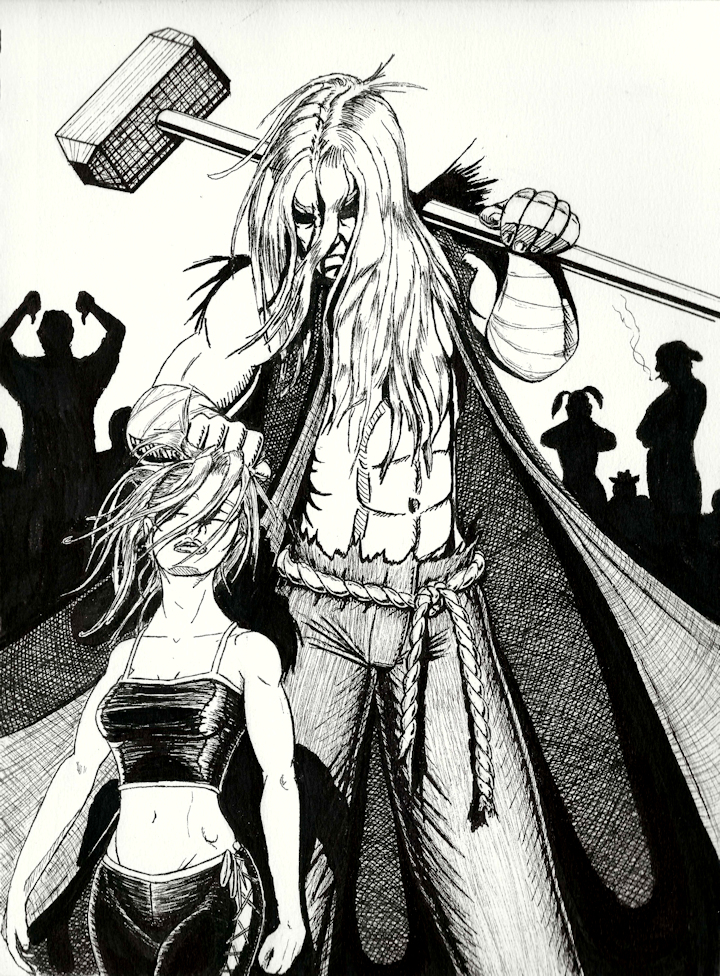 The Champion. (Click to enlarge; double-click to restore.) Concept CommentaryTaking a fistful of her golden locks, the villain drags the crushed heroine to her knees. A soft whimper escapes her lips as her arms dangle lifelessly at her sides. A girl in the crowd shrieks. A man cheers. And a small group begins chanting, "Break her bones! Break her bones!" The Champion tilts her head back and glares down with a raging boil of contempt and disgust, searching for any fight—any challenge—this so-called "challenger" might have. But the beaten girl remains completely unconscious, utterly helpless, and entirely at the mercy of a cruel and unforgiving conqueror ... ... but what happens next? Pain and suffering could await our protagonist, turning her into a cold anti-hero and setting up a story where she comes back for revenge against the man who broke her. Or she could be a hotshot heroine in the classical adventure plot where she challenges the main antagonist early on only to be humbled by a devastating defeat, returning at the end to ultimately succeed where she once failed. This may be one of those final showdowns where the bad guy utterly dominates, but before he can finish her off, she deals a sudden fatal blow at the last possible moment. She could be in an inspirational tragedy where she dies for her people’s freedom, sparking a revolution against the tyrant who murdered her. Or perhaps she’s the final victim in a bleak horror tale where none of the good guys survive. Maybe a deus ex machina is about to sweep in and save her. Or maybe, just maybe, she’s in a nightmare on the verge of waking up. I could have definitively drawn any of those scenarios simply by capturing a different moment in time. I could have drawn the champion crushing her skull beneath his hammer. I could have drawn her reaching for a concealed weapon with her eyes slightly open. I could have drawn a dragon swooping down from the skies. And I could have drawn her waking up from a dream. However, had I pursued any of these alternatives, it would have locked away all of the previous paragraph’s potent what ifs because picking one answer simultaneously crosses out the infinite possibilities. That is the downfall of the definitive. Now, don’t get me wrong, concrete answers have their place, and if handled correctly they can carry enormous power. However, one of my purposes in Challenger II was to create a sense of overwhelming danger, but because the focus of that render was the female Challenger, I wanted her confidence to override all concern. “Don’t worry,” her body language says, “I got this.” So when inspiration struck to do a sequel, I wanted to flip the coin and emphasize the reigning Champion while building on the confrontation in the original. That meant ramping up the threat. And that meant making the protagonist powerless. Threat is the key word. I wanted to create an image with the greatest threat to our heroine. In this image, she can’t defend herself. The Champion owns her. He can do with her as he pleases. He can discard her broken body like a piece of garbage, or he can drag her away and inflict unspeakable horrors upon her until she’s as broken emotionally and mentally as she is physically. And because her fate is not explicitly revealed, the possibilities are limited only by the viewer’s imagination. Even if I drew the most shocking, sadistic, pornographic punishment I could think of, there’s always something worse. By strategically showing the moment of her defeat but not the price she pays for it, there’s never going to be “something worse” because you can’t top something that’s not defined. Granted, this also opens the door for the what ifs described above where she comes out unscathed, but that really doesn’t detract from my intentions because the future possibility of salvation does not negate the present actuality of danger. The threat is still there. If anything, the potential for escape or rescue just adds further intrigue because then the story is not over. There’s still hope.
—Jay Wilson Also available: Technical Commentary |
|
|
